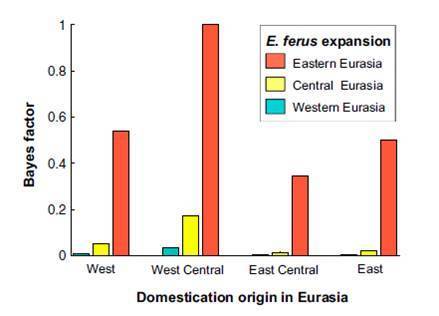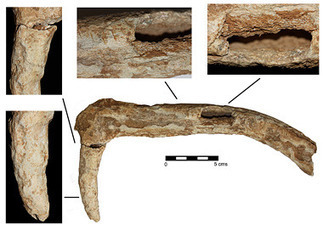Archaeological evidence suggests that humans began frequenting the island of Cyprus by about 12,500 years ago, but little is known about the early Cypriots’ way
of life. Jean- Denis Vigne et al. excavated the Pre-Pottery Neolithic site Klimonas, radiocarbon-dated to 10,600–11,100 years old. Inhabitants of Klimonas had a complex society, demonstrated by the discovery of large structures that were probably used for collective storage, meetings, and rituals. Wheat chaff was detected in some building materials, suggesting the cereal was available in large quantities and that wheat was likely cultivated rather than imported. Numerous stone tools, including some that may have been used to harvest cereals, were also unearthed at the site. According to the researchers, remains of cats provide long-sought evidence for historical interactions between felines and humans. The authors also recovered mouse remains, suggesting that the cats might have helped protect crop stores from rodent pests. Remains of small domestic dogs, brought from the mainland, and a small indigenous Cypriot wild boar were also found, suggesting to the authors that canines were possibly employed in hunting boar. Collectively, the findings suggest that humans established villages in Cyprus shortly after the beginning of agriculture, and that frequent, successful sea crossings were made over long distances—a demonstration of advanced maritime skills, according to the authors. — J.V
of life. Jean- Denis Vigne et al. excavated the Pre-Pottery Neolithic site Klimonas, radiocarbon-dated to 10,600–11,100 years old. Inhabitants of Klimonas had a complex society, demonstrated by the discovery of large structures that were probably used for collective storage, meetings, and rituals. Wheat chaff was detected in some building materials, suggesting the cereal was available in large quantities and that wheat was likely cultivated rather than imported. Numerous stone tools, including some that may have been used to harvest cereals, were also unearthed at the site. According to the researchers, remains of cats provide long-sought evidence for historical interactions between felines and humans. The authors also recovered mouse remains, suggesting that the cats might have helped protect crop stores from rodent pests. Remains of small domestic dogs, brought from the mainland, and a small indigenous Cypriot wild boar were also found, suggesting to the authors that canines were possibly employed in hunting boar. Collectively, the findings suggest that humans established villages in Cyprus shortly after the beginning of agriculture, and that frequent, successful sea crossings were made over long distances—a demonstration of advanced maritime skills, according to the authors. — J.V
Despite decades of research across multiple disciplines, the early history of horse domestication remains poorly understood. On the basis of current evidence from archaeology, mitochondrial DNA, and Y-chromosomal sequencing, a number of different domestication scenarios have been proposed, ranging from the spread of domestic horses out of a restricted primary area of domestication to the domestication of numerous distinct wild horse populations. In this paper, we reconstruct both the population genetic structure of the extinct wild progenitor of domestic horses, Equus ferus, and the origin and spread of horse domestication in the Eurasian steppes by fitting a spatially explicit stepping-stone model to genotype data from >300 horses sampled across northern Eurasia. We find strong evidence for an expansion of E. ferus out of eastern Eurasia about 160 kya, likely reflecting the colonization of Eurasia by this species. Our best-fitting scenario further suggests that horse domestication originated in the western part of the Eurasian steppe and that domestic herds were repeatedly restocked with local wild horses as they spread out of this area. By showing that horse domestication was initiated in the western Eurasian steppe and that the spread of domestic herds across Eurasia involved extensive introgression from the wild, the scenario of horse domestication proposed here unites evidence from archaeology, mitochondrial DNA, and Y-chromosomal DNA.
An antler sickle found in a pit of the first Neolithic phase, an exceptional find as few examples are known from Europe (Flors 2010), forms the subject of this short note. [5000-4700 BC]
The sickle would have been used by holding it at the proximal end, gathering up the stalks with the transversal antler point and holding them in the other hand. At this stage, the sickle would have been turned 90°, so that the stalks could be cut with the blade hafted in the sickle. The analysis of use-wear marks on the Costamar sickle has revealed that the internal face of the distal antler point is intensely polished by friction, presumably when the stalks were gathered up.
Flour milling in the west happens out of view! Here we can see three different grains being milled in two larger stone-mills, each with two pairs of electrically driven stones, and some grinding machines (probably cone pulverizers) are used for smaller quantities of less fine flour and also chillies. We see the traditional Ethiopian grain tef (Teff, Eragrostis tef, with tiny grains 1mm x 0.7 mm), wheat and white maize coming to the mills in 50kg sacks, and then the women sieve and winnow it in the air. It is then put into the grinder. For chilies in the final third of the video, women were buying them in the 5kg quantities in the market and thanking them to be ground at the mill - a quick search suggests that an Indian machine fromhttp://www.brindustries.in/chilly-grinding-plants.htm was being used! The chillies were mostly very hot and the dust caught your throat. There didn't seem to be much protection from explosion in the flour mills.
Unlike the video of the Indian flour mills I posted earlier,http://youtu.be/1tPWqpj4680 , there was no sieving process to separate flour and bran. These mills are in Axum (Aksum), Ethiopia.
Via Annals of Botany: Plant Science Research
In this paper, an ancient visible food remain from Subeixi Cemeteries (cal. 500 to 300 years BC) of the Turpan Basin in Xinjiang, China, preliminarily determined containing 0.432 mg/kg cattle casein with ELISA, was analyzed by using an improved method based on liquid chromatography (LC) coupled with MALDI-TOF/TOF-MS to further identify protein origin. The specific sequence of bovine casein and the homology sequence of goat/sheep casein were identified. The existence of milk component in ancient food implies goat/sheep and cattle milking in ancient Subeixi region, the furthest eastern location of prehistoric milking in the Old World up to date. It is envisioned that this work provides a new approach for ancient residue analysis and other archaeometry field.






